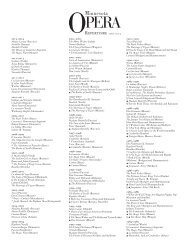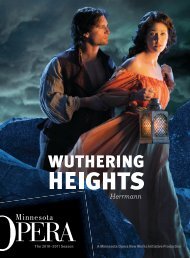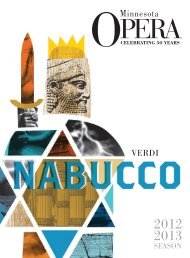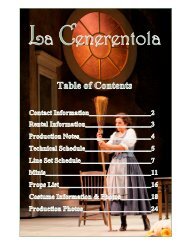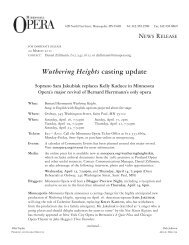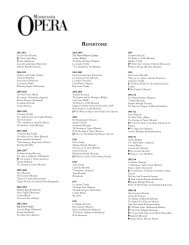You also want an ePaper? Increase the reach of your titles
YUMPU automatically turns print PDFs into web optimized ePapers that Google loves.
operetta<br />
oratorio<br />
orchestra pit<br />
overture<br />
parlando<br />
portamento<br />
principal<br />
proscenium<br />
quartet<br />
recitative<br />
recitativo<br />
accompagnato<br />
recitativo secco<br />
repertory<br />
répétition<br />
revolve<br />
ritornello<br />
rococo<br />
role<br />
A loosely used term, often used interchangeably with comic opera, opéra bouffe, and musical<br />
comedy. In Italian it originally meant “little opera,” a short, light musical work. It has come<br />
to mean a full-length piece on a light subject, with musical numbers and spoken dialogue, and<br />
characterized by ingratiating tunes, decorative dances, colorful settings, social irresponsibility,<br />
a slender dramatic line, and the requirement of at least two well-trained voices.<br />
A musical-dramatic work originating in the twelfth century, now generally performed, in<br />
contradistinction to opera, without action, costumes, and scenery. They are invariably<br />
associated with sacred subjects.<br />
The sunken area in front of the stage where the orchestra sits.<br />
An orchestral introduction to the opera, usually played before the acting begins.<br />
(It: ‘in speaking style’). An informal and realistic technique occasionally used in Italian opera,<br />
bringing singing close to speaking.<br />
An Italian singing term, asking the voice to glide from one note to another at some distance.<br />
An authentic and effective device, to be distinguished from the mannerism of scooping.<br />
A major singing role, or the singer who performs such a role.<br />
The stage opening, resembling a three-sided picture frame. Immediately behind it and<br />
concealing the acting areas is the curtain. The proscenium arch was originally created in the<br />
1700s to conceal the machinery used to create special stage effects.<br />
Four singers, or the music written for that group.<br />
Musical singing in the rhythm of speech.<br />
A sung passage with orchestral accompaniment, lacking the formality of an aria, yet more<br />
declamatory and agitated than recitativo secco.<br />
Dry recitative. A sung passage so close to everyday speech that although the pitches and time<br />
values are respected, a conversational quality prevails. A keyboard instrument generally<br />
supplies the sketchy accompaniment. Commonly used in Italian opera seria and opera buffa.<br />
A system of stage production in which a number of works are played, virtually in rotation, by<br />
a resident company throughout a season.<br />
French term for “rehearsal.” A répétition générale is a dress rehearsal to which critics and<br />
guests are invited.<br />
Revolving stage. Turntable. A section of the stage floor (permanently established) or a circular<br />
construction on a central pivot which revolves, to change scenery or supply movement of<br />
objects as well as people.<br />
A short instrumental piece, literally meaning repetition or refrain. In Monteverdi’s works it<br />
usually consists of a few bars played between the verses of a strophic song.<br />
In art, associated with the late Baroque period and the late eighteenth century. In contrast to<br />
the dignity, heaviness, and occasional pomposity of Baroque, Rococo art is playful, lighter in<br />
tone and color, and adorned with scrolls, acorns, and shells.<br />
The character that a singer portrays.<br />
glossary of opera terms 107



